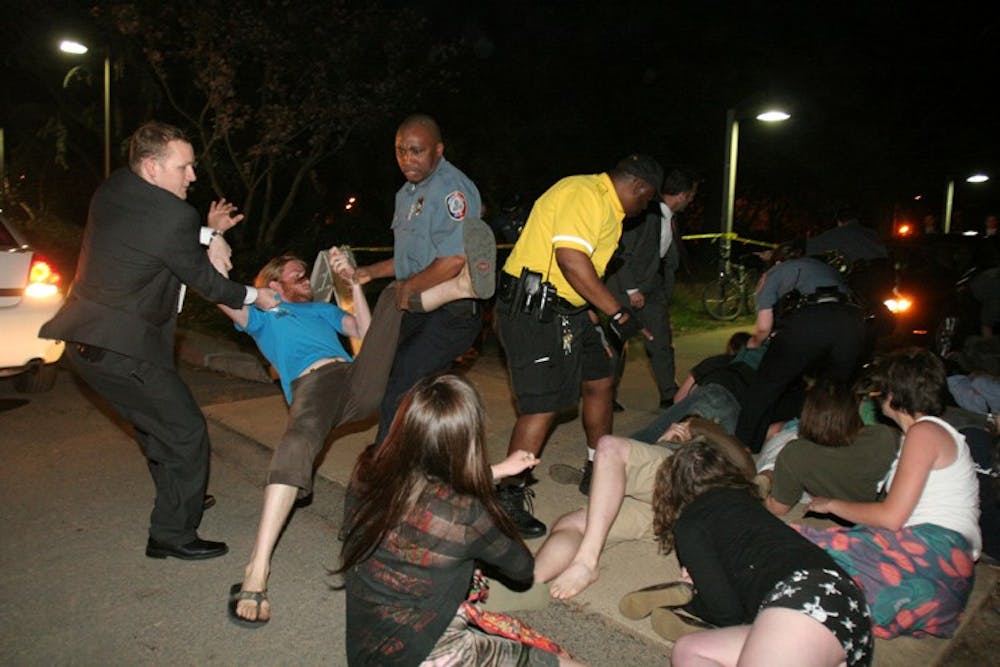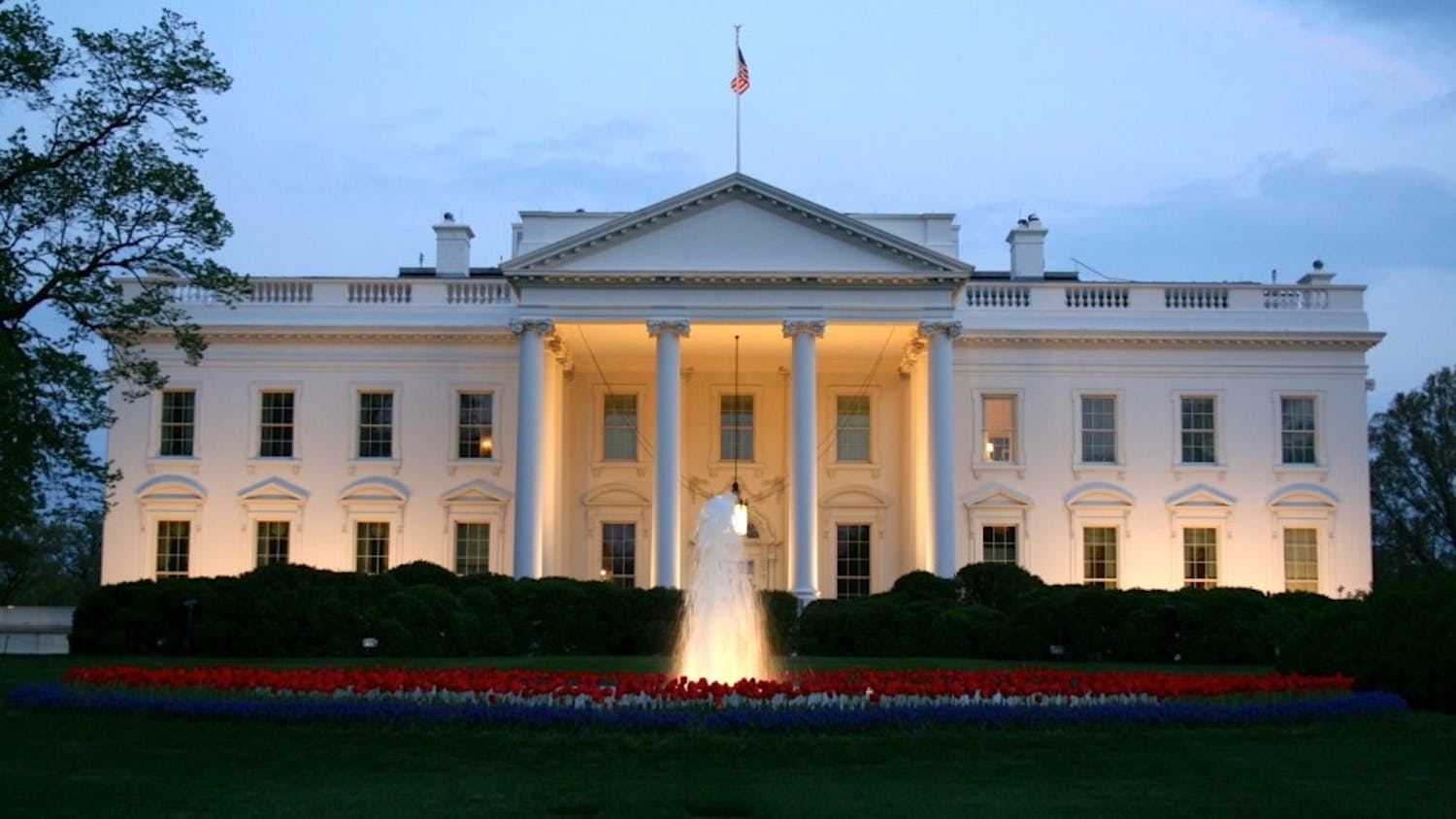In light of the recent Occupy protests on campus and across the country, The Eagle looks back at the most infamous of AU protests.
VIETNAM WAR PROTESTS, May 1970
Tear gas filled the air from Massachusetts Avenue to the Quad as police and students volleyed canisters back and forth over Ward Circle in May 1970. MGC was plastered with scribbled posters warning tear gas victims to keep out. The gas had already seeped into the ventilation in buildings as far as MGC and residual tear gas chemicals on the protesters’ clothes caused other students in the building to experience eye irritation.
Before 1970, AU’s campus had been relatively stable. But when the “Moratorium to End the Vietnam War,” a series of anti-war protests across the country, started that year, on-campus protests began to gain steam.
Students had held demonstrations on campus against the Vietnam War and against racial segregation, but the infamous clash between police and students at Ward Circle in May 1970 sparked a revolution on campus.
School of International Services Professor Gary Weaver, who also edited and contributed to the book “The University and gas mask on the way to his car that day.
“My brother was in the navy at the time and gave it to me,” Weaver said. “He joked, ‘You need it more than I do.’ I used it frequently enough.”
William Causey, a 1971 School of Public Affairs alumnus, was president of the student government at the time of the protests.
While Causey was personally opposed to the war, he saw many D.C. students getting arrested for civil disobedience. Howard University shut down for at least three days in 1968 after students seized administrative buildings, according to The Eagle.
Causey commended then-AU President George Williams for keeping the University open in light of the student protests.
“They were frankly very accommodating and understanding of what was going on with the student body,” Causey said. “There was frankly not a great deal of opposition or resistance to what was happening on campus. I think one of the hallmarks of a university is to promote open, free discussion of an issue.”
With the exception of the tear gas incident, protests at AU were vocal but peaceful.
Then-Secretary of Defense Melvin Laird used to ride his limo home up Massachusetts Avenue by Ward Circle. Students threw marshmallows and leaflets at the car, both of which stuck to the wheels of the car, according to Weaver.
The Secret Service became angry when the car slowed down.
“His car was never stopped,” Causey said of the scene. “But when he went through the circle that one morning when there were a lot of students there, he made a gesture that was not a favorable gesture.”
BENJAMIN LADNER, August 2005
Although former AU President Ben Ladner’s fiscal indiscretions marred AU’s reputation, the incident united the campus.
Ladner, once one of the highest paid university presidents in the country with a salary of $880,750 a year, spent $125,000 from University funds between 2002 and 2005, according to The Eagle.
In August 2005, The Washington Post alleged that Ladner had used the money for personal expenses, including lavish vacations with his family and a personal chef.
The University Board of Trustees offered Ladner $3.75 million to leave the school, a severance package called the “golden parachute” by members of the AU community who were angry with how AU administration handled the Ladner issue.
Students like Megan Linehan, a 2006 College of Arts and Sciences alumna, said the movement against Ladner evolved organically.
With Facebook still in its infancy, Linehan rallied the students the old fashioned way: going door to door in the dorms, chalking the sidewalk and posting flyers.
She said the protests started out small but grew quickly outside a Sept. 27, 2005, Board of Trustees meeting on the issue. Students called for Ladner’s suspension and eventually stormed the meeting in Butler Pavilion, The Eagle previously reported.
Some of Linehan’s rallying methods were less orthodox. She rented a U-Haul for a weekend to protest Ladner’s moving expenses with a homemade sign saying “We’ll move your stuff for free.”
“I just remember driving down Connecticut thinking, ‘I’m gonna hit something,’” Linehan said.
The Ladner scandal resonated with professors as well. Linehan said several faculty let their students out of block classes early to protest.
“We felt a great solidarity; they didn’t seem afraid,” Linehan said.
Still, she and her longtime friend Maeve Reed, a CAS ’06 alumna, had some trepidation the night before the first protest.
“What do you think is going to happen?” Reed said to Linehan that night in her apartment in the Berkshires. “There’s this kind of element where you’re just nervously laughing because Ladner could do whatever he wanted at this point. There was a degree of fear to it as well.”
For Reed though, civil disobedience is a family affair. Her great grandmother was a suffragette and her uncle, also an AU alumnus, was arrested during the Vietnam protests. Her grandparents even had to bail him out of jail.
“My grandparents were really proud and excited that I was out there protesting because they’re kind of activists,” Reed said.
KARL ROVE, April 2007
A smaller, but vocal group of protesters confronted Karl Rove when he spoke in Ward in April 2007. Over 80 students came to Ward to protest Rove, even lying down in front of his limo.
Matt Kent, then-President of the College Democrats and a 2008 SPA graduate, said Rove was a federal criminal because he violated the Presidential Records Act of 1978, the Eagle reported. The Act ensures that all White House written communication is open to the public.
Eagle reporters and other media were cut off from the intimate speech. Tickets had been available through the College Republicans website or at its general meeting, but it had not been advertised on Today@AU. Some protesters complained the event was not publicized enough.
The Community Action and Social Justice Coalition gathered outside Kay Spiritual Life Center before the protest at 5:30 p.m., planning to block Rove’s entrance to Ward, The Eagle previously reported.
The protesters then linked arms, forming a human chain around the building. They let attendees in, but insisted they were there as a group to make a citizens arrest of Rove.
By the time Rove exited the building after the speech, the protest crowd had expanded to almost 100 people.
The protest became physical when 16 demonstrators broke from the crowd to lie in front of Rove’s limo.
Campus police and security guard ran to the protesters and pulled them away. One protester claimed that a Public Safety officer dragged her by her. Another protester was more mischievous in his contempt for Rove, mooning the limo.





